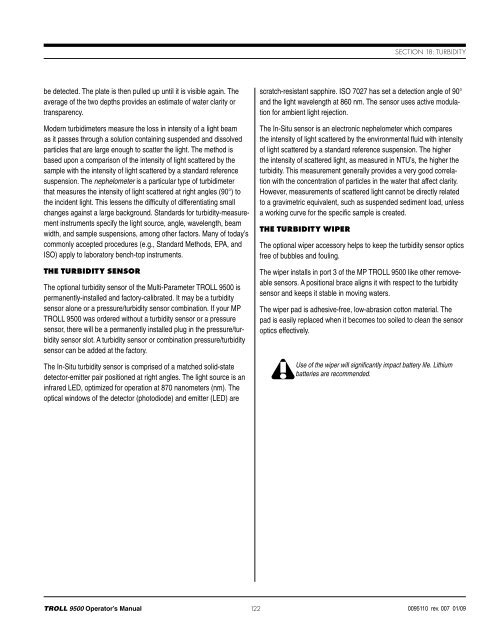TROLL 9500 Operator's Manual - Geotech Environmental Equipment
TROLL 9500 Operator's Manual - Geotech Environmental Equipment
TROLL 9500 Operator's Manual - Geotech Environmental Equipment
You also want an ePaper? Increase the reach of your titles
YUMPU automatically turns print PDFs into web optimized ePapers that Google loves.
Section 18: Turbiditybe detected. The plate is then pulled up until it is visible again. Theaverage of the two depths provides an estimate of water clarity ortransparency.Modern turbidimeters measure the loss in intensity of a light beamas it passes through a solution containing suspended and dissolvedparticles that are large enough to scatter the light. The method isbased upon a comparison of the intensity of light scattered by thesample with the intensity of light scattered by a standard referencesuspension. The nephelometer is a particular type of turbidimeterthat measures the intensity of light scattered at right angles (90°) tothe incident light. This lessens the difficulty of differentiating smallchanges against a large background. Standards for turbidity-measurementinstruments specify the light source, angle, wavelength, beamwidth, and sample suspensions, among other factors. Many of today’scommonly accepted procedures (e.g., Standard Methods, EPA, andISO) apply to laboratory bench-top instruments.The Turbidity SensorThe optional turbidity sensor of the Multi-Parameter <strong>TROLL</strong> <strong>9500</strong> ispermanently-installed and factory-calibrated. It may be a turbiditysensor alone or a pressure/turbidity sensor combination. If your MP<strong>TROLL</strong> <strong>9500</strong> was ordered without a turbidity sensor or a pressuresensor, there will be a permanently installed plug in the pressure/turbiditysensor slot. A turbidity sensor or combination pressure/turbiditysensor can be added at the factory.The In-Situ turbidity sensor is comprised of a matched solid-statedetector-emitter pair positioned at right angles. The light source is aninfrared LED, optimized for operation at 870 nanometers (nm). Theoptical windows of the detector (photodiode) and emitter (LED) arescratch-resistant sapphire. ISO 7027 has set a detection angle of 90°and the light wavelength at 860 nm. The sensor uses active modulationfor ambient light rejection.The In-Situ sensor is an electronic nephelometer which comparesthe intensity of light scattered by the environmental fluid with intensityof light scattered by a standard reference suspension. The higherthe intensity of scattered light, as measured in NTU’s, the higher theturbidity. This measurement generally provides a very good correlationwith the concentration of particles in the water that affect clarity.However, measurements of scattered light cannot be directly relatedto a gravimetric equivalent, such as suspended sediment load, unlessa working curve for the specific sample is created.The Turbidity WiperThe optional wiper accessory helps to keep the turbidity sensor opticsfree of bubbles and fouling.The wiper installs in port 3 of the MP <strong>TROLL</strong> <strong>9500</strong> like other removeablesensors. A positional brace aligns it with respect to the turbiditysensor and keeps it stable in moving waters.The wiper pad is adhesive-free, low-abrasion cotton material. Thepad is easily replaced when it becomes too soiled to clean the sensoroptics effectively.Use of the wiper will significantly impact battery life. Lithiumbatteries are recommended.<strong>TROLL</strong> <strong>9500</strong> Operator’s <strong>Manual</strong> 1220095110 rev. 007 01/09
















